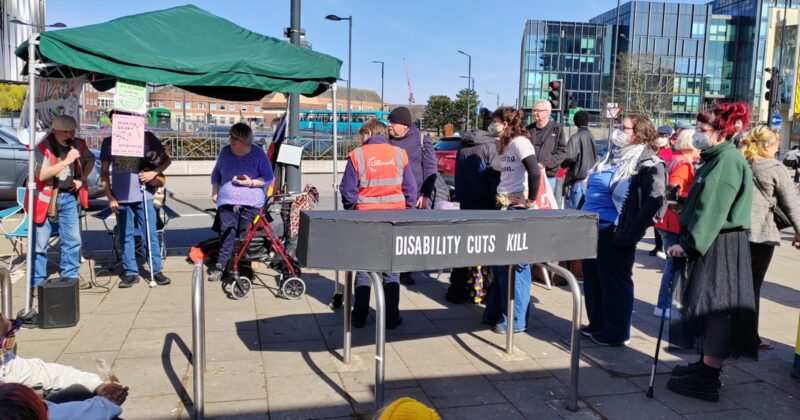For a working class women's movement
Working class women across the country are confronting austerity and winning local battles. Bringing these class fighters together to forge a working class women’s movement has the potential to bring the cuts government to its knees, argues Joy Macready
 You can hear the rumble. Snippets here and there, up and down the country. Impressive victories for Save Lewisham Hospital campaign and the Scottish Anti-Bedroom Tax Federation; a march in Canterbury to save children’s centres; healthworkers in Leeds and Bradford walking out against cost-cutting; Glasgow and Doncaster care workers striking against pay cuts and longer hours; and now teachers are preparing for a national strike on 26 March over worsening of pay, pensions and conditions.
You can hear the rumble. Snippets here and there, up and down the country. Impressive victories for Save Lewisham Hospital campaign and the Scottish Anti-Bedroom Tax Federation; a march in Canterbury to save children’s centres; healthworkers in Leeds and Bradford walking out against cost-cutting; Glasgow and Doncaster care workers striking against pay cuts and longer hours; and now teachers are preparing for a national strike on 26 March over worsening of pay, pensions and conditions.
Working class women are taking to the streets and finding the courage to fight back, at a time when the union leaders are showing an appalling lack of appetite for struggle. These fighting campaigns are not exclusively made up of women, but they are a growing majority.
Working class women are at the forefront because they have no buffer to protect themselves from these vicious attacks. When a local nursery is shut down, it is women who have to work part-time to look after their children because other childcare is too expensive; when care in the community is slashed, it is women who have to look after family and neighbours.
Together, standing shoulder-to-shoulder with our working class brothers, we can turn this constant stream of rebellion into a torrent.
The reality of austerity
Working class women are bearing the brunt of austerity. They are shouldering a severe burden as a result of cuts to benefits and public services imposed by the government since they came to power in May 2010. And there are still more cuts coming down the pipeline: £60 billion over the next four years.
As well as caring for children, women are carers for disabled relatives and for parents in their later years; so the Bedroom Tax, the cuts to Disability Living Allowance and to local authorities’ elderly care fall more heavily on their shoulders.
Meanwhile real earnings have declined, involuntary part-time employment has increased, and for the first time in five years the gender pay gap has widened, now standing at 15.7 per cent. Women pensioners suffer the greatest gap, on average receiving £6,500 a year less than men.
In addition, out of every 100 jobs created in the private sector, only 37 have gone to women. In the public sector, where a majority of women work because benefits such as maternity, parental and care leave are better, an estimated 700,000 workers are expected to lose their jobs by next year. In addition, a shocking 50,000 women lose their jobs while on maternity leave each year.
Cuts to legal aid will disproportionately affect women, as it no longer available to women who need to use the courts in relation to child contact and divorce, unless they can “prove” domestic violence.
Women also face a double-discrimination as migrants and as members of ethnic minority communities, and have been especially scapegoated as such in the context of prolonged economic stagnation. Muslim women have been targeted for wearing the veil and subjected to increased violent attacks.
These are all reasons why we need to fight for a working class women’s movement today.
Building a movement
But what would a working class women’s movement look like? What would it fight for?
A working class women’s movement would link up action groups, campaigns and caucuses in different unions and communities, building working class action to fight for its demands. Strikes, occupations and solidarity would be central.
In almost every big class struggle, like the Great Miner’s Strike, women have begun to organise in their own groups, either building solidarity or as a way of raising their own demands in the male-dominated labour movement. Women need a broad and active movement to fight for their immediate demands, with the political capacity and leadership to take those struggles further and secure genuine advances for women.
In addition to fighting back against the cuts, a working class women’s movement would raise specific demands to combat women’s oppression, such as domestic violence and rape, discrimination at work, the lack of abortion and contraceptive rights, inequalities in pay, inadequate childcare and healthcare, sexist culture, etc.
Many of these demands will also resonate with middle class women that are being thrown back by austerity. And in calling for a working class women’s movement, we are not saying that only working class women could be part of it. Women from other classes would however have to recognise the need to join and support the struggles of the working class. They would have to be won to a class perspective on the fight for women’s liberation.
Likewise we must win working class men to fight consistently for women’s liberation, and against sexism and the institutional obstacles to women’s participation in political life. That is why we need a movement that fights against women’s oppression in every form and wherever it manifests itself.
As socialists, we know that the majority of women will only be liberated and free from discrimination when the economic foundations of class rule and male supremacy are overthrown. Only under a socialist society – run for human need rather than private profit – will women be truly liberated.






